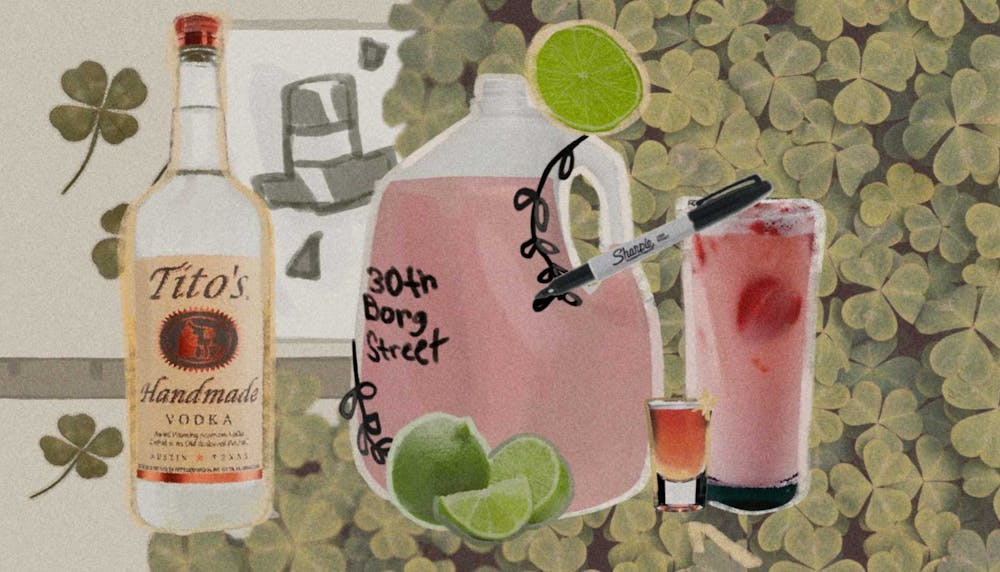What are you doing this summer? “Oh, I’m interning at BORGan Stanley.”
Who's your favorite rapper? “PlayBORG Carti.”
What’s that song from The Wizard of Oz? “Somewhere Over the RainBORG.”
These are just some examples of the playful, culture–conscious names that can likely be found scrawled across gallon bottles repurposed as Blackout Rage Gallons, fondly known as BORGs.
The Blackout Rage Gallon is an apt descriptor for what it is: a gallon of water refilled with an alcoholic concoction for maximum partying. To make a BORG, students empty a gallon of water about halfway, add in a mixture of alcohol, maybe a mixer or two, usually food coloring, and sometimes pedialyte or another electrolyte. BORGs are particularly popular on game days, and at Penn they can be spotted on the two biggest darty days of the year: Homecoming and St. Patrick’s Day. Students then write a clever title incorporating the word “BORG” on one side of the BORG for photography purposes.
The trend of BORGs has gained steam on TikTok, with college students across the country posting videos of them making their BORGs and taking them to parties.
Although popular for some time now, the BORG is finally being acknowledged by adults who seem quite concerned about the new party prop. The New York Times published an article around the time of St. Patrick’s Day this year, asking the questions: What is a BORG? Is it dangerous? The answers they received, as to be expected, differed between students and adults.
Sarah Andrews, an assistant professor from Johns Hopkins, denounced BORGs while speaking to The Times, arguing that “Just because you know what is in it doesn’t mean that you truly understand the negative effects it could have … Even if it’s mixed with electrolytes, it doesn’t offset the alcohol content. It doesn’t offset the dangerousness of the alcohol.” Evidently, some professionals do not agree with some students’ sentiments that BORGs are “safer” methods of drinking.
The Massachusetts Institute of Technology also highlighted the “myths” associated with BORGs, warning students that “[d]iluting a BORG with water and adding electrolytes will NOT prevent the toxic effects of consuming this much alcohol” and that “BORGs often lead to increased blood alcohol content which heightens the risk of being targeted for sexual assault.”
The concern for students is valid and valuable; however, students themselves have raised competent counterarguments to these criticisms of BORGs, claiming that they feel safer with a BORG than with other popular drinking methods on campus.
Some students have argued that BORGs also help protect against drink spiking, since the BORG's contents are entirely decided by the owner, and it is capped. Of course, if someone leaves their BORG unattended, there is still a risk of it being tampered with, but students often prefer this level of vigilance as opposed to relying on the drinks provided by fraternities. The ingredients of a BORG also take into account hydration and hangover prevention, which is harder to manage after drinking hard alcohol or beer at parties all day.
One student explains to The Times, “‘It is nice that you can put a cap on it instead of, like, if you’re at the bar and you have an open drink, someone can easily just, like, 'roofie' you,”’ which is a concern for many people at college parties. A 2016 survey found that 8% of over 6,000 surveyed college students said they were victims of spiking, with 80% of that 8% being women.
BORGs may not be a perfect solution to dangerous drinking, but it does give more agency to students who do not trust alcohol provided to them at parties. BORGs are trendy and online–friendly, especially with its viral naming conventions, but they also serve practical purposes. It is certainly not a “healthy” way to drink, but for long days of being out in the sun, jumping from party to party, it might not be such a bad idea to opt for a BORG that is half filled with water rather than a can of beer or a cup of boxed wine. If you’re responsible with making your BORG, you know you can trust its contents, which is invaluable for many college students in the dangerous climate of partying.







